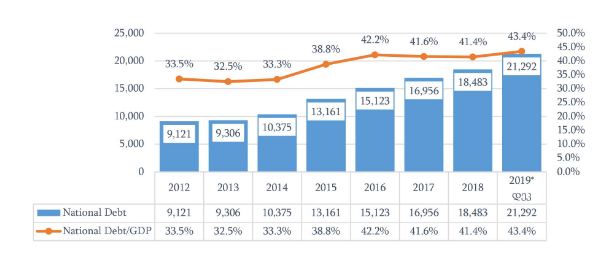Resume: As of December 2019, Georgia’s national debt is GEL 20 billion which is 2.2 times larger as compared to the national debt in 2012. However, speaking of debt, discussing a relative figure is more appropriate as compared to an absolute figure because a certain absolute figure could be very large against a small economy and very small against a larger economy. Furthermore, the author of the statement touches upon quite a large time span during which the GDP was also constantly growing.
As compared to 2012, the debt to GDP ratio[1] has increased nearly 1.2 times instead of being doubled. The government debt dynamic is also similar. In addition, of note is that the growth of the government debt was largely stipulated by a recalculation of the previously accumulated debt balance in accordance with the new exchange rate and the authorities are only partially responsible[2] for this.
Therefore, the author of the statement gives flawed absolute figures (2012’s figure is stated less than it actually was whilst 2019’s figure is stated more than it actually was and the growth figure was bloated inflated as a result of these calculations). In addition, it neglects the commonly accepted form of analysing the debt to GDP ratio and simultaneously overlooks another important factor causing the change – exchange rate fluctuation – which is not subject to the complete control of any single country’s authorities.
Analysis
The leader of the political party Lelo for Georgia, Mamuka Khazaradze, in his briefing in front of Tbilisi City Court, stated: “In the last seven years, debt increased 2.5 times and reached GEL 22.5 billion whilst seven years ago it was nearly [GEL] nine billion.”
The total national debt constitutes the sum of the total foreign debt (including the debt of the National Bank) and the total domestic debt. The total government debt as opposed to the total national debt does not include the obligations of the National Bank.
As of December 2019, Georgia’s national debt is GEL 20 billion which is 2.2 times larger as compared to the national debt in 2012. However, whilst discussing the debt, using a relative figure is more appropriate as compared to an absolute figure because a certain absolute figure could be very large against a small economy and very small against a larger economy. As compared to 2012, the debt to GDP ratio has increased nearly 1.2 times instead of being doubled. The government debt dynamic is also similar.
Graph 1: Total National Debt[3] (GEL Million, GDP %)
National Debt
National Debt/GDP
Source: Ministry of Finance
In addition, whilst indicating the debt growth, the fluctuation of the GEL exchange rate in the given period is an aspect which needs to be taken into account. In particular, after changes in the exchange rate, the new exchange rate is applied for the calculation of not only the added debt in a period (debt taken in one year) but the balance figure of the debt previously accumulated (the unpaid part of the debt taken in the past). Therefore, the growth of government debt was largely stipulated by a recalculation of the previously accumulated debt balance in accordance with the new exchange rate.
[1]This article uses the GDP figures measured by anupdated methodology. Therefore, the relative figures are different from the previous analysis where GDP figures were used prior to the update.
[2]National currencies have depreciated against the USD en masse and the Georgian currency was not an exception in that regard.
[3]2019’s GDP is a forecast figure.








